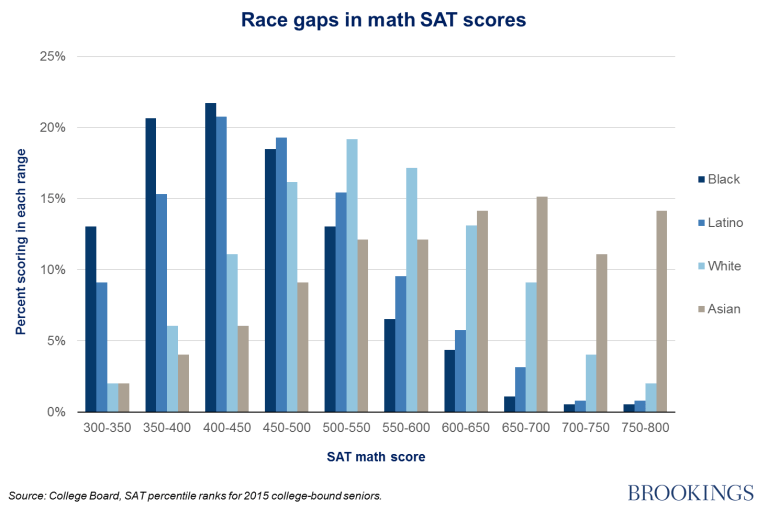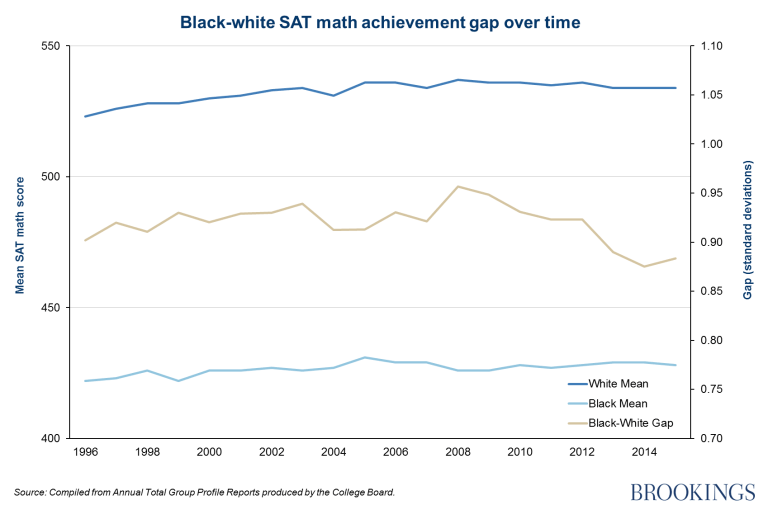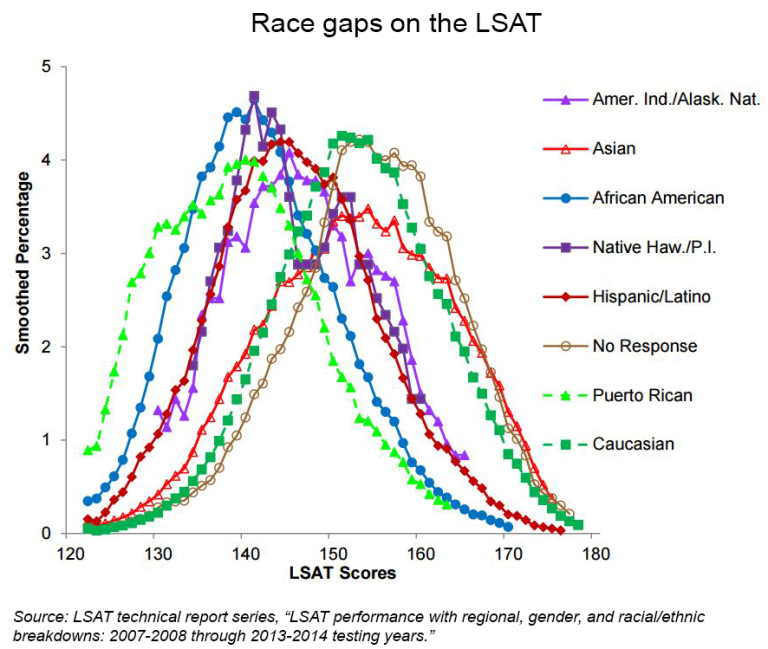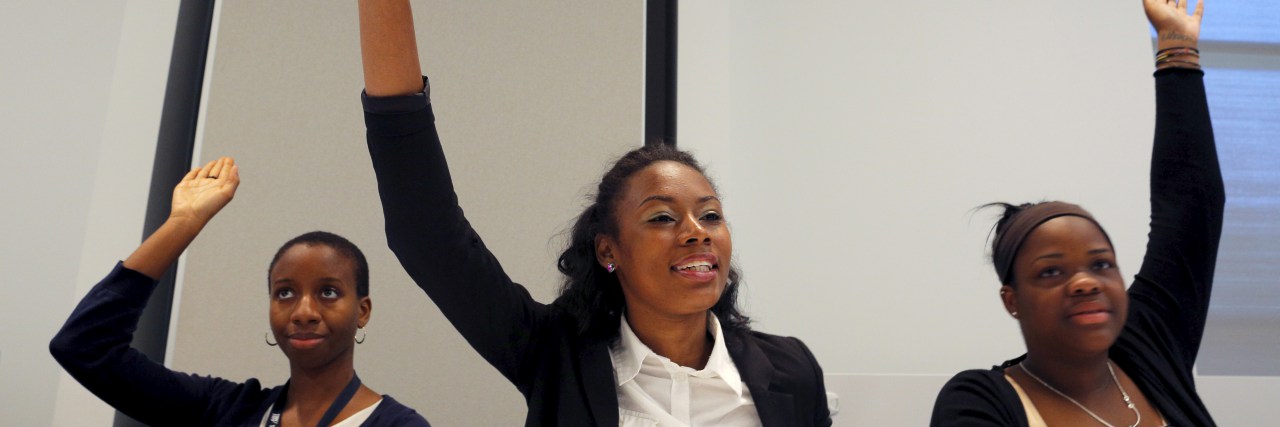
Written by Richard V. Reeves and Dimitrios Halikias
Wednesday, February 1, 2017- brookings.edu
Taking the SAT is an American rite of passage. Along with the increasingly popular ACT, the SAT is critical in identifying student readiness for college and as an important gateway to higher education. Yet despite efforts to equalize academic opportunity, large racial gaps in SAT scores persist.
The great score divide
The SAT provides a measure of academic inequality at the end of secondary schooling. Moreover, insofar as SAT scores predict student success in college, inequalities in the SAT score distribution reflect and reinforce racial inequalities across generations.
In this paper, we analyze racial differences in the math section of the general SAT test, using publicly available College Board population data for all of the nearly 1.7 million college-bound seniors in 2015 who took the SAT. (We do not use the newest data released for the class of 2016, because the SAT transitioned mid-year to a new test format, and data has so far only been released for students who took the older test.) Our analysis uses both the College Board’s descriptive statistics or the entire test-taking class, as well as percentile ranks by gender and race. (The College Board has separate categories for “Mexican or Mexican American” and “Other Hispanic, Latino, or Latin American.” We have combined them under the term Latino.)
The mean score on the math section of the SAT for all test-takers is 511 out of 800, the average scores for blacks (428) and Latinos (457) are significantly below those of whites (534) and Asians (598). The scores of black and Latino students are clustered towards the bottom of the distribution, while white scores are relatively normally distributed, and Asians are clustered at the top:

Race gaps on the SATs are especially pronounced at the tails of the distribution. In a perfectly equal distribution, the racial breakdown of scores at every point in the distribution would mirror the composition of test-takers as whole i.e. 51 percent white, 21 percent Latino, 14 percent black, and 14 percent Asian. But in fact, among top scorers—those scoring between a 750 and 800—60 percent are Asian and 33 percent are white, compared to 5 percent Latino and 2 percent black. Meanwhile, among those scoring between 300 and 350, 37 percent are Latino, 35 percent are black, 21 percent are white, and 6 percent are Asian:

The College Board’s publicly available data provides data on racial composition at 50-point score intervals. We estimate that in the entire country last year at most 2,200 black and 4,900 Latino test-takers scored above a 700. In comparison, roughly 48,000 whites and 52,800 Asians scored that high. The same absolute disparity persists among the highest scorers: 16,000 whites and 29,570 Asians scored above a 750, compared to only at most 1,000 blacks and 2,400 Latinos. (These estimates—which rely on conservative assumptions that maximize the number of high-scoring black students, are consistent with an older estimate from a 2005 paper in the Journal of Blacks in Higher Education, which found that only 244 black students scored above a 750 on the math section of the SAT.)
A stubborn black-white gap
Disappointingly, the black-white achievement gap in SAT math scores has remained virtually unchanged over the last fifteen years. Between 1996 and 2015, the average gap between the mean black score and the mean white score has been .92 standard deviations. In 1996 it was .9 standard deviations and in 2015 it was .88 standard deviations. This means that over the last fifteen years, roughly 64 percent of all test-takers scored between the average black and average white score.

These gaps have a significant impact on life chances, and therefore on the transmission of inequality across generations. As the economist Bhashkar Mazumder has documented, adolescent cognitive outcomes (in this case, measured by the AFQT) statistically account for most of the race gap in intergenerational social mobility.
Could the gap be even wider?
There are some limitations to the data which may mean that, if anything, the race gap is being understated. The ceiling on the SAT score may, for example, understate Asian achievement. If the exam was redesigned to increase score variance (add harder and easier questions than it currently has), the achievement gap across racial groups could be even more pronounced. In other words, if the math section was scored between 0 and 1000, we might see more complete tails on both the right and the left. More Asians score between 750 and 800 than score between 700 and 750, suggesting that many Asians could be scoring above 800 if the test allowed them to.
A standardized test with a wider range of scores, the LSAT, offers some evidence on this front. An analysis of the 2013-2014 LSAT finds an average black score of 142 compared to an average white score of 153. This amounts to a black-white achievement gap of 1.06 standard deviations, even higher than that on the SAT. This is of course a deeply imperfect comparison, as the underlying population of test-takers for the LSAT (those applying to law school) is very different from that of the SAT. Nonetheless the LSAT distribution provides yet another example of the striking academic achievement gaps across race:

Another important qualification is that the SAT is no longer the nationally dominant college-entrance exam. In recent years, the ACT has surpassed the SAT in popularity. If the distributions of students taking the two exams are significantly different, focusing on one test alone won’t give a complete picture of the racial achievement gap. A cursory look at the evidence, however, suggests that race gaps on the 2016 ACT are comparable to those we observe for the SAT. In terms of composition, ACT test-takers were 54 percent white, 16 percent Latino, 13 percent black, and 4 percent Asian.
Except for the substantially reduced share of Asian test-takers, this is reasonably close to the SAT’s demographic breakdown. Moreover, racial achievement gaps across the two tests were fairly similar. The black-white achievement gap for the math section of the 2015 SAT was roughly .88 standard deviations. For the 2016 ACT it was .87 standard deviations. Likewise, the Latino-white achievement gap for the math section of the 2015 SAT was roughly .65 standard deviations; for the 2016 ACT it was .54 standard deviations.
Or could the gap be narrower than it looks?
On the other hand, there is a possibility that the SAT is racially biased, in which case the observed racial gap in test scores may overstate the underlying academic achievement gap. But most of the concerns about bias relate to the verbal section of the SAT, and our analysis focuses exclusively on the math section.
Finally, this data is limited in that it doesn’t allow us to disentangle race and class as drivers of achievement gaps. It is likely that at least some of these racial inequalities can be explained by different income levels across race. Unfortunately, publicly available College Board data on class and SAT scores is limited. The average SAT score for students who identify as having parents making between $0 and $20,000 a year is 455, a score that is actually .2 standard deviations above the average score for black students (428). These numbers are fairly unreliable because of the low rates of student response; some 40 percent of test-takers do not list their household income. In comparison, only 4 percent of test-takers fail to provide their racial identification.
However, a 2015 research paper from the Center for Studies in Higher Education at the University of California, Berkeley shows that between 1994 and 2011, race has grown more important than class in predicting SAT scores for UC applicants. While it is difficult to extrapolate from such findings to the broader population of SAT test-takers, it is unlikely that the racial achievement gap can be explained away by class differences across race.
Down with standardized tests?
Given the reliance of colleges on test scores for admissions, the gaps in SAT math performance documented here will continue to reproduce patterns of inequality in American society. It seems likely, however, that colleges rely too heavily on such tests. Research from William Bowen, Matthew Chingos, and Michael McPherson suggests that high school grades may have more incremental predictive power of college grades and graduation rates. The SAT may not be a good measure of student potential.
Even to the extent that SAT scores do predict college success, it is far from clear that universities are justified in basing admissions so strongly on the exam. After all, a wide range of other morally relevant considerations—questions of distributive justice, for example—may well need to be weighed alongside considerations of academic preparation.
Significant racial and class inequalities much earlier in life explain persistent obstacles to upward mobility and opportunity. The extensive racial gaps in academic achievement and college preparation across high school seniors are symptomatic of those deeper drivers of inequality. Accordingly, policy efforts may be more effective if they target underlying sources of these achievement gaps. That means experimenting with earlier childhood interventions of the sort we have described elsewhere: increasing cash transfers to disadvantaged parents with young children, improving access to quality preschool programs, pursuing paid leave policies to allow for more quality parent investment during the first years of life, teaching parents the skills they need to effectively raise their children, and so on.
It is also important to bear in mind that despite persistent gaps in test scores, racial gaps in college enrollment have actually been closing in recent years. In fact, the college enrollment gap by income is now significantly larger than by race. The challenge now is about college graduation rates (where race gaps have not closed) as much as college enrollment: for graduation rates, race gaps remain larger than income gaps.
It is also clear, however, that when such large gaps have opened up by the end of the high school years, equalizing outcomes at the college level will be an almost impossible task. Interventions at the end of the K-12 years, or in the early stages of college, can often be too little, too late.
Debates over the fairness, value and accuracy of the SAT are sure to continue. The evidence for a stubborn race gap on this test does meanwhile provide a snapshot into the extraordinary magnitude of racial inequality in contemporary American society. Standardized tests are often seen as mechanisms for meritocracy, ensuring fairness in terms of access. But test scores reflect accumulated advantages and disadvantages in each day of life up the one on which the test is taken. Race gaps on the SAT hold up a mirror to racial inequities in society as a whole. Equalizing educational opportunities and human capital acquisition earlier is the only way to ensure fairer outcomes.















